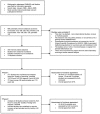Survey of the quality of experimental design, statistical analysis and reporting of research using animals
- PMID: 19956596
- PMCID: PMC2779358
- DOI: 10.1371/journal.pone.0007824
Survey of the quality of experimental design, statistical analysis and reporting of research using animals
Abstract
For scientific, ethical and economic reasons, experiments involving animals should be appropriately designed, correctly analysed and transparently reported. This increases the scientific validity of the results, and maximises the knowledge gained from each experiment. A minimum amount of relevant information must be included in scientific publications to ensure that the methods and results of a study can be reviewed, analysed and repeated. Omitting essential information can raise scientific and ethical concerns. We report the findings of a systematic survey of reporting, experimental design and statistical analysis in published biomedical research using laboratory animals. Medline and EMBASE were searched for studies reporting research on live rats, mice and non-human primates carried out in UK and US publicly funded research establishments. Detailed information was collected from 271 publications, about the objective or hypothesis of the study, the number, sex, age and/or weight of animals used, and experimental and statistical methods. Only 59% of the studies stated the hypothesis or objective of the study and the number and characteristics of the animals used. Appropriate and efficient experimental design is a critical component of high-quality science. Most of the papers surveyed did not use randomisation (87%) or blinding (86%), to reduce bias in animal selection and outcome assessment. Only 70% of the publications that used statistical methods described their methods and presented the results with a measure of error or variability. This survey has identified a number of issues that need to be addressed in order to improve experimental design and reporting in publications describing research using animals. Scientific publication is a powerful and important source of information; the authors of scientific publications therefore have a responsibility to describe their methods and results comprehensively, accurately and transparently, and peer reviewers and journal editors share the responsibility to ensure that published studies fulfil these criteria.
Conflict of interest statement
Figures
Comment in
-
Getting personal with the "reproducibility crisis": interviews in the animal research community.Lab Anim (NY). 2018 Jul;47(7):175-177. doi: 10.1038/s41684-018-0088-6. Lab Anim (NY). 2018. PMID: 29942056 Free PMC article. No abstract available.
References
-
- Russell WMS, Burch RL. The Principles of Humane Experimental Technique. London: Metheun. 1959. Available: http://altweb.jhsph.edu/pubs/books/humane_exp/het-toc#. Accessed 20 October 2009.
-
- Festing MW, Overend P, Gaines Das R, Cortina Borja M, Berdoy M. London: Royal Society of Medicine Press Ltd (for Laboratory Animals Ltd); 2002. The design of animal experiments: Reducing the use of animals in research through better experimental design. pp. 1–16. In: Laboratory Animal Handbooks No 14.
-
- Festing MF, Altman DG. Guidelines for the design and statistical analysis of experiments using laboratory animals. ILAR Journal. 2002;43(3):244–258. - PubMed
-
- Johnson PD, Besselsen DG. Practical aspects of experimental design in animal research. ILAR Journal. 2002;43(4):202–206. - PubMed
-
- Shaw R, Festing MF, Peers I, Furlong L. Use of factorial designs to optimize animal experiments and reduce animal use. ILAR J. 2002;43(4):223–232. - PubMed
Publication types
MeSH terms
LinkOut - more resources
Full Text Sources


